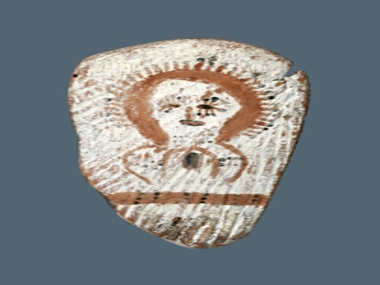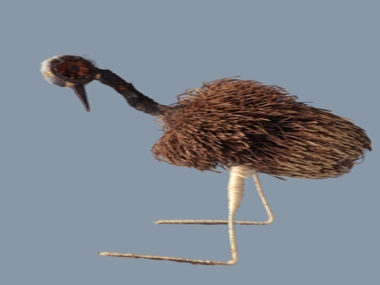FIRST AUSTRALIAN ART FOR FIRST AUSTRALIAN SAINT

Ochre on bark, this is believed to be one of the earliest portable Wandjinas in existence. Photo: Pietro Zigrossi. Copyright: Vatican Museum
Posted by Jeremy Eccles | 17.10.10
Dates:
15.10.10
Location: Vatican Museum of Ethnology
Aboriginal artworks sent from Catholic missions in the north and west of Australia earlier last century are on display at the Vatican’s Ethnological Museum in Rome to coincide with today's canonisation of Mary MacKillop. And their presence was celebrated with Aboriginal music and dance in St Peter's Basilica.
The Vatican’s collection of Aboriginal artworks came for an exhibition organised in 1925 which brought together more than 100,000 ethnographic objects from the Church's missions in the Americas, Asia, Africa and Oceania. When the exhibition closed, 40,000 objects were kept for the Vatican Collection, including 300 from Australia.
Today's exhibition, RITUALS OF LIFE – the Spirituality and Culture of Aboriginal Australians through the Vatican Collection - is a partnership with the National Museum of Australia. A team led by the Museum’s senior Indigenous Curator Margo Neale has assisted the Vatican with research into the origins of the artworks and their display.
“The National Museum of Australia has an important role to play in assisting Indigenous
communities to reconnect with their cultural legacy through historic collections held overseas;
this has been a key element of the Vatican project,” explained Andrew Sayers, Director of the
National Museum of Australia.
“Using the objects to re-connect with Indigenous communities is very important to us,” added
Father Nicola Mapelli, Director of the Vatican Ethnological Museum. “Through the objects we can show the living story of a people: their history, hopes, joys and desires. At the Vatican Museums, we can show the people visiting here from around the world something about the wonderful living culture and spirituality of Indigenous Australia”.
According to the Vatican Museum website, “The exhibition was inspired by the desire to honour Indigenous Australian Art as being one of the oldest artistic expressions on our planet. The exhibition is permeated by spirituality and allusions to the ancestral world of one of our most ancient human civilisations. Aboriginal civilisation inhabited the Australian continent at least 60,000 years before the arrival of the "white man". Even though they do not have a written language, the Aboriginal people have managed to pass on their culture via myths and paintings, songs and dances & their story continues until our days. That which we nowadays call "art" is nothing more than the transposition into concrete and material forms of the cultural identity of a civilisation profoundly and proudly linked to their past and to their land”.
Most of the Australian collection at the Vatican dates from the late 19th century to 1920, and is mainly from communities on the Tiwi Islands north of Darwin, Kalumburu in the far northern Kimberley, and the monastery at New Norcia near Perth.
“Museums in the 21st Century can no longer ignore indigenous peoples, their rights and responsibilities” said Professor Neale. “Our research in Australia led us to relatives of those who made the items in the Vatican Collection. Some remembered those who made the objects, others identified works as made by their fathers or uncles. And all were proud that the works 'were with the Pope in Rome, close to the Sistine Chapel'”.
Works include a set of ten Pukamani Poles, plus ceremonial body wear, spears, paddles and
an extraordinary range of shields. Of particular significance is an exquisite Wandjina song cycle consisting of 13 small paintings on slate which is thought to refer to the Stations of the Cross and was created in the first decades of the last century.
The exhibition also inaugurates a new area within the Ethnological Museum which will henceforward host temporary exhibitions of objects and artefacts offered to the Pontiffs over the years by private donors, Catholic Missions and Dioceses from all over the world.
URL: http://mv.vatican.va/3_EN/pages/z-Info/MV_Info_Etnologico.html
Share this:
»  del.icio.us
»
del.icio.us
»  Digg it
»
Digg it
»  reddit
»
reddit
»  Google
»
Google
»  StumbleUpon
»
StumbleUpon
»  Technorati
»
Technorati
»  Facebook
Facebook
Contact Details

Cassowary chick or emu from central Queensland, made around 1910. Photo: Pietro Zigrossi. Copyright: Vatican Museum
Further Research
News Tags: National Museum of Australia | St Mary MacKillop | Vatican
Exhibition Archive
- 10.10.17 | TARNANTHI 2017
- 11.08.17 | Natsiaas 2017
- 20.07.17 | APY ART DOMINATES THE WYNNE
- 17.07.17 | Anangu Artist Wins $100,000 Prize
- 14.07.17 | The End of AAMU
- 11.07.17 | ART ACROSS THE COUNTRY
- 11.07.17 | TARNANTHI IN OCTOBER
- 05.07.17 | TJUNGUṈUTJA - from having come together
- 13.06.17 | Ghost-Nets Straddle the World
- 07.06.17 | Grayson Perry Going Indigenous?
- 05.06.17 | Barks Bigger than Ben Hur
- 27.05.17 | NGA QUINQUENNIAL 2017
- 21.05.17 | Blak Douglas Finds Home at the NGA
- 21.05.17 | BRIAN ROBINSON WINS HAZELHURST WOP
- 18.05.17 | PARRTJIMA 2.0
Advertising

